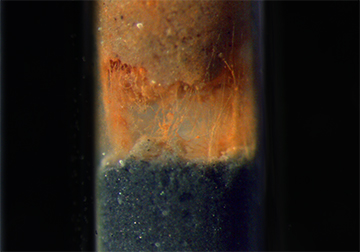
Cable bacteria in between two layers of sediment split apart inside a glass cylinder. [Image: Nils Risgaard-Petersen and Lars Peter Nielsen / Aarhus University (via Wikimedia Commons)]
Less than a decade ago, scientists discovered cable bacteria—filament-shaped microbes that actually conduct electricity for centimeter-scale distances through layers of marine sediments. Using resonance Raman spectroscopy and other optical probes, researchers based in Denmark have measured the voltage loss along the filaments to learn how far these bacteria can carry current (Proc. Natl. Acad. Sci. USA, doi:10.1073/pnas.1800367115).
What are cable bacteria?
Members of the family Desulfobulbaceae, cable bacteria live in the surface sediments at the bottom of both fresh and brackish bodies of water. Their multicellular structures extend up to 1.5 cm in length and are 0.4 to 1.7 μm in diameter. The microbes oxidize hydrogen sulfide in the oxygen-poor depths of the sediment and transport electrons toward the water–sediment boundary, where they reduce molecular oxygen.
Researchers from the Center for Electromicrobiology at Aarhus University, Denmark, put filaments of cable bacteria into a microscope chamber containing oxygen and sulfide sources at opposite ends, 5 mm apart. The strands aligned themselves by swarming toward the oxygen source, with their opposite ends remaining in the low-oxygen sediment. The team then recorded nearly 2,000 Raman spectra of the microbial filaments and mapped the redox states of the cytochromes—specialized proteins that play an important role in electron transport in living cells.
Electrical experiments
In a subsequent experiment, the scientists cut off electron transport within the cable bacteria by snipping the filaments with a laser microdissection microscope. The bacterial fragments buried in the low-oxygen sediments soon showed a loss of electrical potential, compared with control cable bacteria that remained intact. The same thing had happened when the researchers cut off the oxygen source to uncut cable bacteria.
From the spectroscopic measurements, the team calculated that an individual strand of cable bacteria was losing voltage at a rate of 12 to 14 mV per millimeter of length. Thus, the filaments can transport electrons along a maximum distance of about 3 cm before moving to reach either the oxygen-rich zone or the sulfide-rich zone in sediment layers. Other bacteria can conduct electricity only over micron-scale distances.
Scientists from universities in Belgium, Austria and the Netherlands also participated in the study.
